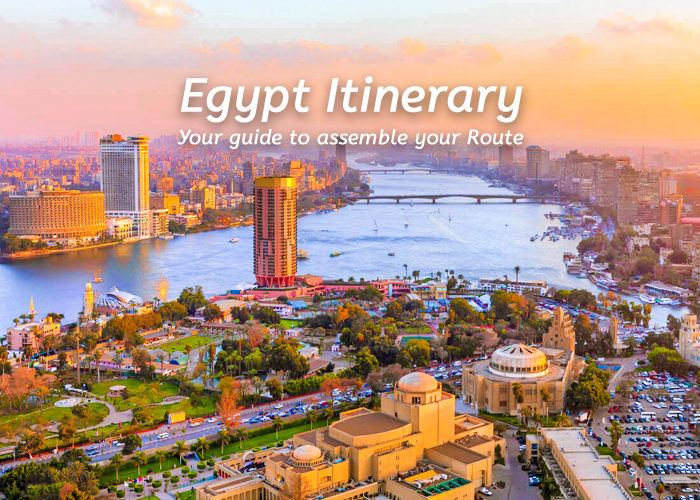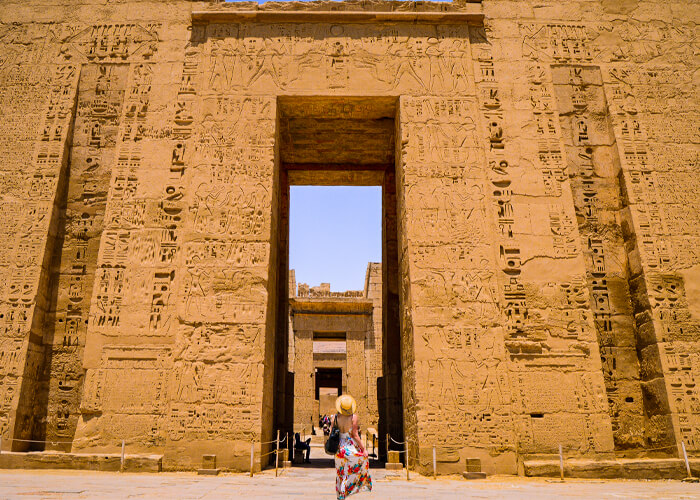The opening of the National Museum of Egyptian Civilization is one of the most important tourist landmarks in Egypt in recent times.
Despite the passage of time, the stunning images of the Royal Mummies Parade that took place on April 3, 2021, which took place around the world, remain in everyone’s memory: the mummies of the important pharaohs and queens of ancient Egypt were displayed on the streets of Cairo as they were transported from the Egyptian Museum to their new home in the Museum of Egyptian Civilization.

But what is this newly opened museum all about, what are its attractions, how does it complement the other major museums in the capital and neighboring Giza? We talk about it briefly in this post, so that you can decide whether you want to include it in your travel itinerary or not.
Contents:
- What is the National Museum of Egyptian Civilization?
- Where is the Egyptian National Museum?
- Who built the National Museum of Egyptian Civilization?
- What is the collection of this museum-like? What are its main attractions?
- What are the royal mummies that were transferred to the museum?
- Is the Grand Egyptian Museum the same as the National Museum of Egyptian Civilization?
What is the National Museum of Egyptian Civilization (NMEC)?
It is one of the largest international museums for exhibition, conservation, research, and dissemination of Egyptian history, as it is the first museum dedicated to the most ancient and prehistoric civilizations. The exhibits of the Museum were transferred from other museums in Egypt such as the Cairo Museum, the Museum of Islamic Art, the Coptic Museum, the Museum of the Royal Jewels in Alexandria.

Where is the Egyptian National Museum?
It is located in the city of Fustat (the first Arab capital in Egypt), part of Old Cairo, overlooking the “Ain Al Sira” hot spring.
Who built the National Museum of Egyptian Civilization?
In 1982, UNESCO, at the request of the Egyptian government, campaigned to build the National Museum of Egyptian Civilization in Cairo. In 1999, they searched for a suitable site near the Fustat, and the present site was chosen. The first stone was laid in 2002 during the era of President Mohamed Hosni Mubarak to make it one of the largest and most important antiquities museums in the country.
In 2017, French Ricciardone, the director of the American University in Cairo, donated 5000 artifacts to the National Museum of Egyptian Civilization.
In February of the same year, the National Museum was partially opened, only the temporary exhibition hall of 1000 meters including a temporary exhibition entitled “Egyptian Handicrafts and Industries through the Ages”, aiming to show the development of Egyptian handicrafts (ceramics, weaving, carpentry, ornaments).
This exhibition includes about 420 artifacts selected from some museums, models, in addition to large screens showing documentary films On April 3, 2021, 22 mummies of 18 pharaohs and four queens were transported to the museum by the Egyptian Museum in an event called “Golden Parade of the Royal Mummies”. This event marked the official inauguration of the National Museum of Egyptian Civilization.

Construction of the National Museum of Egyptian Civilization.
The design of the Museum is by an Egyptian architect who was the winner of the international architectural competition. The National Museum of Egyptian Civilization is 23,236 square meters.
The Museum exhibits a collection of 50,000 artifacts that reflect the development of Egyptian civilization since prehistoric times. The collection is divided into two separate sectors; one thematic and the other chronological.
The chronological collection goes back to the following eras; prehistoric, archaic, pharaonic, Greco-Roman, Coptic, medieval, Islamic, modern, contemporary.
The thematic collection reflects the development of civilization, the Nile, writing, society, culture, material, religion, thought, in addition to the room of the Royal Mummies.

What is the collection of this museum-like? What are its main attractions?
It covers all phases of the history of these people. That is to say, it begins precisely at the dawn of this civilization, in the so-called pre-dynastic and archaic period, up to the recent contemporary period. Therefore, it is not only possible to find pieces and objects from the Pharaonic period, but also other important historical phases, such as the Roman, Coptic, and Arabic, from the Middle Ages to the present day.
However, the museum not only organizes its rooms chronologically but also thematically. In that sense, the most attractive rooms are undoubtedly those dedicated to the royal mummies that paraded through Cairo in April 2021. This is the case of the kings Seqenenra Taa (XVII Dynasty), Ahmose I (XVII Dynasty), or Ramses II (XIX Dynasty), as well as the queen-pharaoh Hatshepsut and other monarchs such as Ahmose-Nefertari and Tiye.
Some of the most important pieces are also located in the Central Hall, where important sculptures of famous figures such as Akhenaten, grave goods from ancient Egyptian tombs, and furniture from historic mosques are exhibited.
The Museum of Egyptian Civilization is still in the process of enriching its holdings, so it is to be expected that its rooms and collections will be expanded or modified. And this museum, the nearby Grand Egyptian Museum at Giza, and the entire promotional strategy of both have made one thing clear: the country has entered a new phase in which its historical heritage has become a great spectacle to attract an increasing number of travelers from all over the planet.

The rooms of the Museum:
- The permanent (main) hall: which houses numerous unique exhibits and is designed to offer the development of Egyptian civilization and traditional Egyptian folk culture from the prehistoric period, through the Pharaonic, Greco-Roman to contemporary Egypt.
- The Royal Mummies hall: this room is specially designed to exhibit the 22 mummies of ancient kings and queens, the most famous mummies are of Hatshepsut, Ramses II, Thutmose III, Tiy.
- Temporary exhibition halls and exhibitions in modern Cairo.
What are the royal mummies that were transferred to the museum?
Moving Mummies from the Egyptian Museum in Cairo to the National Museum of Egyptian Civilization in Fustat
The Royal Mummies are transported from the Egyptian Museum in Tahrir Square in a grand 21st-century event on April 3. In the old museum, the Royal Mummies were displayed in a small room, but currently, the Mummies are displayed together with their sarcophagi in a modern room in boxes with better temperature and humidity conditions for the mummies.
The mummies are 18 mummies of kings and 4 mummies of queens. Originally the mummies were in the tomb of Deir Al Bahari (DB 320), near the Temple of Hatshepsut, and in the tomb of Amenhotep II (KV 35) in the Valley of the Kings, to preserve them away from their original tombs.
Mummies that were discovered in the Deir Al Bahari;
- The Mummy of Seqenenra, who ruled from 1558 to 1555 BC. It is the last of the XVII dynasty.
- The Mummy of Amosis I, who ruled Egypt from 1549 to 1524 BC. C. He was the liberator of Egypt from the Hyksos.
- The Mummy of Amenhotep I, who ruled Egypt from 1525 to 1504 BC. His tomb (KV 39) was discovered in the Valley of the Kings.
- The Mummy of Tutmosis I, who ruled from 1506 to 1493 BC. His tomb (KV 38) is in the Valley of the Kings.
- The Mummy of Tutmosis II, who ruled Egypt from 1493 to 1479 BC. C. His tomb (KV 20) is in the Valley of the Kings.
- The Mummy of Tuthmosis III, who ruled the country from 1479 to 1425 C. The number of his tomb in the Valley of the Kings is KV 34.
- The Mummy of Seti I, who ruled from 1294 to 1279. His tomb (KV 17) in the Valley of the Kings was discovered in 1817.
- The Mummy of Ramses II, who ruled Egypt from 1279 to 1213 BC. C. His tomb KV 7 in the Valley of the Kings.
- The Mummy of Ramses III, who ruled from 1186 to 1154. His tomb (KV3) is located in the Valley of the Kings.
- The Mummy of Ramses IX, who ruled Egypt from 1129 to 1111 C. His original tomb is (KV 6) in the Valley of the Kings.
- The Mummy of Ahmose-Meritamón is the daughter of King Seqenenra (of the seventeenth dynasty).
- The Mummy of Ahmose-Nefertari is the wife of Amosis I. Her tomb is TT 359 in Deir el Madina.
- The Mummy of Hatshepsut, who ruled Egypt from 1490 to 1468 as a mighty pharaoh, his tomb in the Valley of the Kings KV 20.
Mummies that were discovered in the tomb of Amenhotep II in the Valley of the Kings;
- The Mummy of Amenhotep II, who ruled Egypt from 1427 to 1401 BC. His tomb is KV35 in the Valley of the Kings.
- The Mummy of Tutmosis IV, who ruled from 1401 to 1391 BC. His mummy was originally in his tomb (KV 43).
- The Mummy of Amenhotep III, who ruled Egypt from 1390 to 1353 BC. C. His tomb is WV22 in the Valley of the Kings.
- The Mummy of Meren-Ptah, who ruled from 1213 to 1203 BC. C. and he was the fourth pharaoh of the XIX dynasty and the son of Ramses II.
- The Mummy of Seti II, who ruled from 1200 to 1294 BC. His tomb was discovered in the Valley of the Kings (KV 15).
- The Mummy of Ramses IV, who ruled from 1155 to 1149 BC. His tomb is tomb KV 2 in the Valley of the Kings.
- The Mummy of Ramses V, who ruled from 1149 to 1145 BC. C. The tomb of Ramses V is KV 9 in the Valley of the Kings.
- The Mummy Ramses VI, who ruled the country from 1143 to 1136 BC. His tomb is of the number KV 9 in the Valley of the Kings.
- The Mummy of Tiy is the wife of Amenhotep III. It is believed that she was buried in the Amarna tomb or tomb WV 22 in the Valley of the Monkeys.
Is the Grand Egyptian Museum the same as the National Museum of Egyptian Civilization (NMEC)?
It is important not to confuse this museum with the Great Egyptian Museum, considered the largest archaeological museum in the world and located just a couple of kilometers from the Pyramids of Giza. Instead, the Museum of Egyptian Civilization was inaugurated in 2017 and, since then, has been enriching its collection with contributions from other museums, such as the famous arrival of the Pharaonic mummies.

Discover all that Egypt has to offer with Us
Egypt always has everything new for its tourists, so let’s visit and discover this new Museum by booking a day tour with the other Old Cairo attractions of Mosques, Churches, bazaars, and more. With our Egypt vacation packages enjoy a different historical experience in Cairo with a Nile cruise between Luxor and Aswan.













































